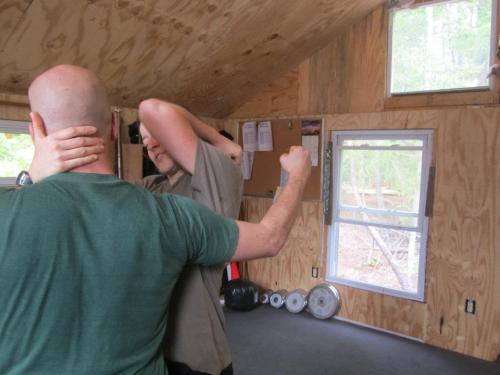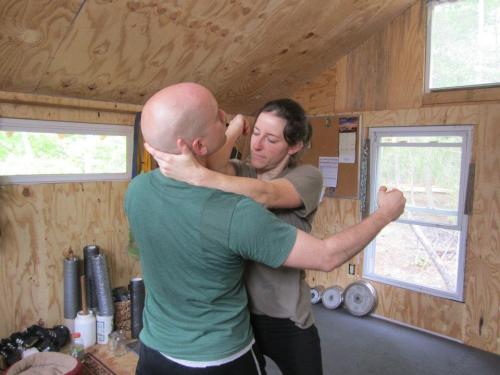One of our VA students exploring the utility of the elbows at close range to strike upwards and/or cover, then strike downwards into the throat or clavicles on the return. The collar tie can come out of the strike or cover, or from the other arm, and gives her the ability to create a force couple between elbow and target.
FSRI Contributors:
- Gillian Russell
- David Chopper Campbell
- kevinpreilly
- Randy Simpson, M.S.
- Robert Miller CPT CES PES
-
Recent Posts
Anatomy Resources
Blogroll
DIY Training Equipment
FSRI Clubs
FSRI Original Research
- Epistemic Viciousness in the Martial Arts
- Change Blindness and it's Relationship to Training
- More on Rhabdomyolysis and the Fighting Arts
- Understanding Karate by De-emphasizing Kata
- Applying Sports Science to the Fighting Arts
- More on Perception: Don't Just Rely on Visual Input
- Evidence Based Practice in the Fighting Arts: Appraisal and Suggestions
- Bernard Bettelheim: The Misadventures of a Missionary in 18th Century Okinawa
FSRI Training/Teaching Resources
- Stretches for Striking
- Vertebral Artery and Carotid Artery Dissection Resulting From Mild Neck Trauma
- Injury Comeback Story: complete ACL tear (part 1)
- More for the Core: Are Sit-ups Helping Your Lower Back, or Hurting?
- Knee Osteoarthritis in the Fighting Arts and Combat Sports
- Health, Injuries, Limitations, and Challenges
- Regarding hurdler's Stretches and Kicking
- Stretches for Striking
- Lat Stretches
- Thoracic Outlet Syndrome-What You Should Know
Mugs and T-shirts
Recommended Fighting Arts
Recommended Trainers
Research Resources
- Journal of Sports Science and Medicine
- Athletic Insight: The Online Journal of Sport Psychology
- Google Scholar
- Stick Grappler's Martial Arts Archives
- PubMed
- InYo:The Journal of Alternative Perspectives on the Martial Arts and Sciences
- University of Hawaii Okinawa Collection: Digitized versions of historical karate texts
- Journal of Combative Sport
- Internet Public Library
- Dept. of Justice Violent Crime Stats
Resources for Women Dealing with Violence
- National Coalition Against Domestic Violence
- Violence against women related resources at feminist.com
- Domestic Violence Agencies on the Internet
- Domestic Violence and Abuse: Help, Treatment, Intervention, and Prevention at Helpguide.org
- "911 for Women" Links Page for the Feminist Majority Foundation
Strength & Conditioning Resources
- Race Rx Labs
- Stumptuous
- Link Related to the Q Angle
- Beast Skills Tutorials
- National Exercise & Sports Trainers Association
- ACL Injury Prevention for Female Athletes (PEP Program)
- National Academy of Sports Medicine
- Female Athletes and Serious Knee Injuries
- Fitness for the Fighting Arts
- Sports Fitness Advisor
Useful Misc. Links
Past Articles:





![IMG_0730[1]](https://fightsciencesresearchinstitute.files.wordpress.com/2011/10/img_07301.jpg?w=300&h=225)



 are available here.
are available here.